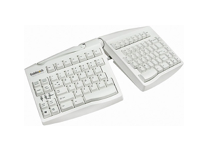Assistive Technology & Accessibility
Press Tech for Seniors with Memory Loss to play
Assistive technology refers to any method of using adaptive technologies to promote independence and enhance participation in daily and meaningful activities.
- Assistive technology should be purchased or used after consultation from a professional.
- Accessibility features are available on every device, no consultation is necessary except to promote effective methods for utilization
Types of Assistive Technology
Adaptive Keyboards and Ergonomics

Problem: Difficulty positioning your hands on a standard keyboard
Solution: A split keyboard comes on a slant or can be adapted or mounted in a position that works for your

Problem: Difficulty coordinating fine motor movements
Solution: Key Guard allows you to elect one key at a time for improved accuracy

Problem: Pain/discomfort during computer work
Solution: Body mechanics!
- Make frequent position changes
- Ideally, your knees, hips, and elbows should be at a 90 degree angle and with your back against a chair with lumbar support.
- Use a pillow for proper management of your affected extremity or placing your keyboard and mouse on a lap pad.
- Stay relaxed and comfortable!
Adaptive Mice

Problem: Difficulty bringing your forearm into a complete palm down position because of muscle paralysis, fusion, or tone
Solution: Ergonomic mouse allows you to keep your wrist in a neutral position

Problem: Limited shoulder movement, but still have movement in fingers
Solution: Access your laptop with just one finger using an adjustable trackpad that can be mounted in any position that works for you
Switches
Switches are used by individuals who are highly affected by stroke. They serve as a simplified means of accessing devices and allow individuals to use what movement they do have to promote independence. For a breakdown of switch use, click here.

Problem: Both sides of your body were affected by your injury, tremors, limited mobility
Solution: A button switch allows for the use of scanning or scrolling to select options on your computer or device
- A button switch is a broad term for various types/shapes of button-like switches.
- Types: pillow switch, jelly bean switch, or PalPad switch
- Cann be placed or mounted by any body part that works best for you, from your cheek to your hand

Problem: Limited/no movement in arms
Solution: Sip and puff switch allows you to make selections/access your computer or control your wheelchair with your breath

Problem: Limited/no movement or coordination
Solution: The Self-Calibrating Auditory Tone Infrared or SCATIR Switch allows them to make selections and access devices with any minor movement.
- Works by breaking the infrared beam projected by the switch.
- The SCATIR switch works with movements like raising an eyebrow, eye movements/blinking, or raising a finger.
Accessibility Features

Voice Over
Problem: Fine motor or vision deficits
Solution: Tells you what is happening on your screen for easier navigation
- "Spoken Content" reads text on screen
- "Audio Description" describes images on screen
All 3 available for: iPhone, iPad, and Mac

Accessibility Keyboard
Problem: Limited finger mobility or coordination, tremors
Solution: Use onscreen keyboard using your mouse
- Slow Keys ensures your computer only processes key strokes you mean to make
- Sticky Keys allows you to enter key combinations one at a time for easier use of keyboard shortcuts
- Mouse Keys allows you to control your mouse with keyboard keys
- Pointer Control uses movement of your head instead of mouse button.
Accessibility Keyboard available for: Mac
Other keyboard features available for: iPhone, iPad, Mac, and iPod touch

Assistive Touch
Problem: Decreased fine motor control/coordination, tremors
Solution: Allows you to replace gestures with movements that are suitable for you to access your phone
- If you cannot pinch the screen to zoom, you can create a gesture you can do to magnify your screen.
- Other "Touch Accommodations" allow you to adjust the sensitivity and hold time for screen touches to avoid accidental swipes and typing.
Assistive Touch is available for: iPhone, iPad, iPod touch
Touch Accommodations are available for: iPhone, iPad, iPod touch, Apple Watch, and HomePod

Voice Control
Problem: Limited fine motor or arm control, endurance problems
Solution: Allows you to access your phone, edit text, move items, and more with just your voice
Available for: iPhone, iPad, Mac, and iPod touch

Safari Reader
Problem: Cognitive or visual impairments
Solution: Removes all unnecessary screen content, so using the internet is less confusing/overwhelming
Available for: iPhone, iPad, Mac, and iPod touch
Accessibility Features For Android
Check out Android's Disability Support feature to get more personalized assistance related to accessing your Android device(s).

Voice Access
Problem: Fine motor, cognitive, or visual deficits
Solution: Access your phone with voice commands (text messages, changing screens, etc.)

Lookout
Problem: Visual or cognitive deficits
Solution: Lookout identifies any object you point your camera at

Live Transcribe
Problem: Hearing or memory deficits
Solution: Allows you to transcribe auditory input or voices/conversations in real time
Apps and Downloads for Accessibility
Medical News Today recommends 10 apps following a stroke. Saebo and "My Therapy" recommend these apps based on specific impairments.


Orientate
Problem: Pain, cognition, or perceptual deficits (neglect)
Solution:
- Rapidly shows images of a left or right foot in various positions and the user must identify it as left or right
- Has been shown to reduced pain, improve movement, and improve perception of the two sides of the body
Cost: Free for Android and iPhone and Google Play







